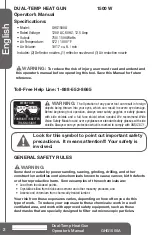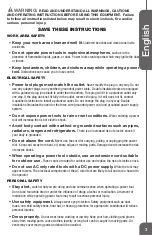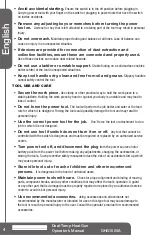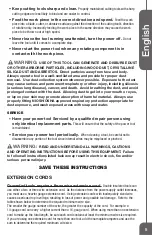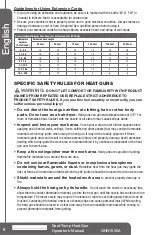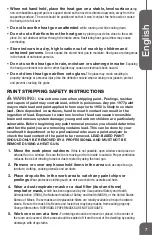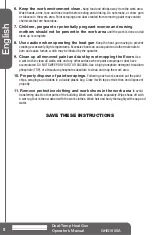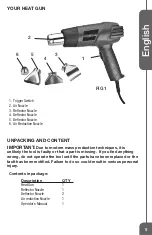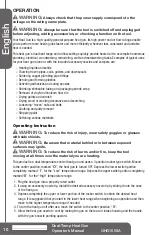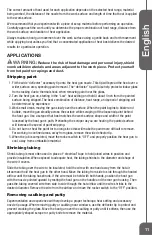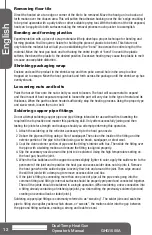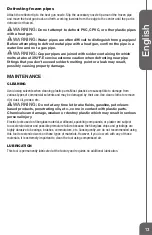
11
English
The correct amount of heat used for each application depends on the selected heat range, material
being worked, the distance of the nozzle from the work surface and length of time that heat is applied
to the work surface.
We recommend that you experiment with a piece of scrap material before performing an operation.
Carefully approach the work until you determine the proper combination of heat range, distance from
the work surface and duration of heat application.
Always maintain heat gun movement over the work surface using a gentle back and forth movement
while applying heat unless you find that a concentrated application of heat best delivers the desired
results for a particular operation.
APPLICATIONS
WARNING:
Reduce the risk of heat damage and personal injury, shield
combustible materials and areas adjacent to the work piece. Protect yourself
from hot paint scrapings and dust.
Stripping paint
1. Fit the wide “deflector” accessory tip onto the heat gun nozzle. This tip will spread the heat over a
wider surface area, speeding paint removal. The “deflector” tip will also help protect window glass
from cracking due to thermal shock when removing paint near the glass.
2. Turn the heat gun on, starting in the “Low” heat setting and hold it about 1inch from the painted
surface being stripped. The best combination of distance, heat range, and speed of stripping will
be determined by experience.
3. Work small areas, moving the gun slowly over the surface. When the paint begins to blister and
bubble, move the gun steadily across the surface while scraping off the loosened paint behind
the heat gun. Use a scraper that best matches the work surface shape and width of the paint
loosened by the heat gun's path. Preheating the scraper as you are heating the painted surface
will increase the speed of paint stripping.
4. Do not burn or heat the paint for too long since this will make the paint more difficult to remove.
For working in confined areas, away from glass, remove the wide deflector tip.
5. When the job is completed, move the rocker switch to “OFF” and properly position the heat gun to
cool, away from combustible material.
Shrinking tubing
Shrink tubing is most often used in place of “electrical” tape to hold joined wires in position and
provide insulation. When exposed to adequate heat, the tubing shrinks to the diameter and shape of
the wire it covers.
Slide the tubing over the wire to be insulated; hold the wire with one hand away from the hot air
stream and hold the heat gun in the other hand. Move the tubing from side to side through the heated
airflow until the tubing has shrunk. If the wire must be held with both hands, position the heat gun
with the nozzle pointed upward by resting the heat gun on the handle and the rear gun housing. Then
pass the tubing covered wire from side to side through the hot airflow until the wire shrinks to the
desired diameter. Remove the wire from the airflow and move the rocker switch to the “OFF” position.
Removing caulking and putty
Experimentation and experience will help develop a proper technique, heat setting and accessory
nozzle tip usage. When removing putty or caulking near windows, use the deflector tip to protect and
prevent cracking the glass. Move the heat gun over the caulking or putty until it softens, then use the
appropriately shaped scraper or putty knife to remove the material.


